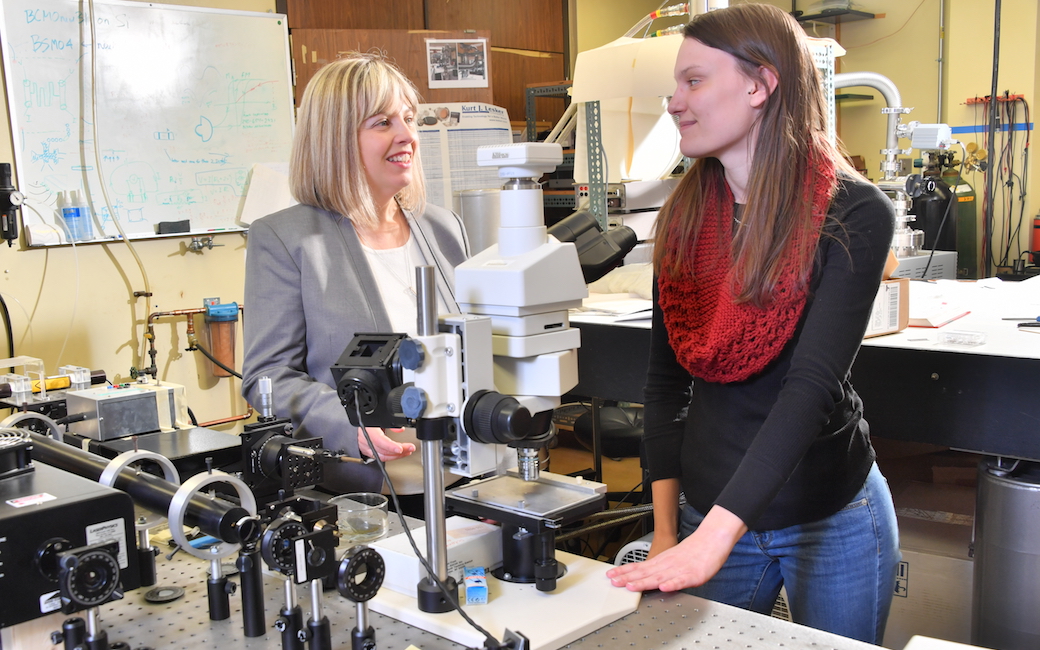DARPA funding assists TU’s Smolyaninova in researching superconductivity
Physics professor finds physics of superconductors “fascinating”
By Megan Bradshaw on August 16, 2019

Towson University Jess and Mildred Fisher College of Science and Mathematics physics professor Vera Smolyaninova has been researching the development of invisibility cloaking for over a decade and has recently turned her attention to a related branch of physics: metamaterial superconductors.
“Before superconductors, I was working on artificial electromagnetic materials or ‘metamaterials,’ says Smolyaninova. “It appears that some similar concepts apply to superconductivity. Superconductivity is interesting to study because of the fascinating fundamental physics involved and also the great potential applications.”
Read a profile of Vera Smolyaninova
Smolyaninova one of five TU faculty receiving 2017–18 USM Board of Regents Awards
Her research team—composed of individuals from the National Institute of Standards and Technology (NIST), the Naval Research Laboratory and the University of Maryland—developed the idea of metamaterial superconductors in 2013, with funding from the Defense Advanced Research Projects Agency (DARPA) administered through the U.S. Army Combat Capabilities Development Command Army Research Office and the Office of Naval Research (ONR).
Superconductors are used in magnetic resonance imaging (MRI) machines in hospitals, trains with magnetic levitation and as component parts in generators and motors. Future applications could include power lines without losses or quantum computers.
Below she answers some questions about her recent research, Observation of Plasmon-Phonons in a Metamaterial Superconductor Using Inelastic Neutron Scattering, which was published in the journal Physical Review B.
What are superconductors? Are there any naturally occurring ones?
Superconductors are materials that lose resistance to electric current at low temperatures, therefore they do not dissipate energy through heating—as regular wires do—when electric current is passed through them. Natural superconductivity occurs at very low temperatures in several metals and compounds, such as aluminum, niobium, some niobium compounds and some cuprates.
Why are superconductors difficult to use in practice?
Superconductors need to be cooled to very low temperatures with cryogenic liquids such as liquid nitrogen and liquid helium. To keep superconductors at such low temperatures, they also need to be shielded from the environment. This makes using superconductors expensive and inconvenient.
What are metamaterials, and how do they solve the problem of impractical superconductors?
Since the discovery of superconductivity, physicists have been searching for new materials—natural or synthesized chemically—that would have superconductivity at higher temperatures, and be more convenient to use. Metamaterials are artificial structures whose properties may be optimized for increased superconductivity at higher temperatures. This approach could lead to the development of superconducting materials by design.
Why choose aluminum-based metamaterials in your experiments?
Aluminum is a conventional superconductor with well-studied and understood properties. This makes aluminum-based metamaterials a good model system. Its properties may be used to guide the study of more complex materials.
What is a plasmon-phonon? What is the likelihood of it increasing the superconducting properties in other materials?
Since superconductors do not have electrical resistance, that means electrons—carrying electrical current—are going through the superconductor freely, without collisions with atoms or each other. These superconducting electrons achieve this in a conventional superconductor by slightly displacing the surrounding atoms or through vibrations of atoms, which are called phonons. So, in a way, electrons in a superconductor are “talking” to each other through lattice vibrations or phonons. In this work, we wanted to understand how electrons interact with each other in our metamaterial superconductor. We found that a combined, new excitation—or vibration—exists in the aluminum metamaterial, which involves both atomic and electronic vibrations. This is called a plasmon-phonon. This plasmon-phonon is probably responsible for the enhancement of superconductivity in the aluminum-based metamaterial.
How do you see this research progressing?
We are going to apply the knowledge gained in studies of aluminum metamaterials to more complex superconducting systems in order to make them superconductive at higher temperatures. Now we are working (in collaboration with Temple University) on fabricated superconductor/insulator systems using such superconductors as magnesium diboride, niobium titanium nitrate (in collaboration with Jefferson Lab) and on self-assembled insulating inclusions in rare-earth bismuth oxides (in collaboration with the University of Cambridge.
This story is one of several related to President Kim Schatzel’s priorities for Towson
University: TU Matters to Maryland.